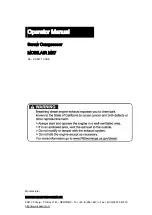
25
INSTALLATION
Duct hot air outside, if necessary, to prevent excessively high ambient temperatures. Ducting should never
be smaller than the size of the cooler face and may need to be enlarged to ensure proper air flow without
creating back pressure. Use sweeps instead of 90° turns. Heated air off of the cooler may be routed to
heat other shop areas using a diverter in the duct. Inlet air may be ducted to the intake air filter(s) sized so
a vacuum greater than 0.25 inHg is not created at the air filter.
4.5.1 AIR-COOLED COMPRESSORS
For air-cooled compressors, the location where the compressor is installed must allow sufficient unob
-
structed airflow in and out of the compressor to maintain a stable operating temperature.
4.5.2 WATER-COOLED COMPRESSORS
For water-cooled compressors, the cooling water supply must be checked for adequate temperature, flow
rate and pressure required to cool the compressor. The recommended water pressure range is 40–75 psig
(2.8–5.2 bar). Refer to
2 SPECIFICATIONS
for cooling water flow rates. Water flow rates will vary by operat
-
ing condtions. Consult the nearest Sullivan-Palatek representative for flow rates based on criteria other
than what is listed.
CAUTION!
The maximum water temperature is 85°F (29°C) to properly cool a water-cooled compressor.
4.6
ELECTRICAL CONNECTIONS
All internal wiring is done at the factory; however all electrical connections must be checked for tightness
because they may have become loose during shipping and installation. Check the electrical supply for
adequate wire size and capacity. The NEMA electrical enclosure supplied with your compressor must be
appropriate to the area in which it is installed. NEMA 4/12 enclosures are standard.
A certified electrician must do the wiring to the compressor in accordance with the National Electric Code
(NEC), local electrical codes and Occupational Safety and Health Administration (OSHA) worker safety
regulations. The compressor must also be grounded properly in accordance with all applicable codes.
Three phase power terminates at connections L1, L2, and L3 on the motor contactor. Make sure the wire
is of sufficient size for the amperage of the compressor. Make sure it is a good electrical and mechanical
connection, and no hairs are sticking out.
The ground wire must be terminated to the ground terminal in the electrical panel and secured as needed.
For single phase power, the ground serves as the neutral for the 115 VAC supply.
Electrical power, should be brought into the starter box to maintain the maximum distance allowable from
the overload and hourmeter as these devices are sensitive to EMFs (Electrical Magnetic Field). Secure the
wiring as needed.
The conduit termination (entrance into the box) must be sealed to maintain the original NEMA rating for
the starter box.
Enclosed machines must have the conduit routed continuously through the enclosure – no termination
at enclosure panels. Entrances into the enclosure should be made with consideration of future needs to
remove panels for maintenance or service without disturbing the electrical installation and to maintain
sound attenuation.
4.7
FLUID LEVEL CHECK
After installing the compressor and before starting the compressor for the first time, verify that the fluid
level is correct. The compressor is filled with the correct amount of fluid before shipping. If the compressor
has the right amount of fluid, the sightglass should be solid (all fluid) while the compressor is off (see
6.5.1
Check
). If the fluid level is low or empty, check for leaks before doing anything else. If fluid must be added,
remove fill cap and fill to edge of port (see
6.5.2 Fill
). Replace and tighten to SAE specification.
CAUTION!
Do not overfill. System could produce excess fluid in compressed air lines and controls.
4.8
DIRECTION OF ROTATION
CAUTION!
Reverse rotation will cause damage that is not covered by the warranty.
NOTE!
Rotation must be checked whenever the compressor has been moved to a new location or after any
change or reconnection of the main electrical wiring.
Summary of Contents for SP20
Page 12: ...4 Introduction ...
















































